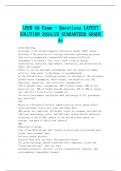LEED GA Exam - Questions LATEST
SOLUTION 2024/25 GUARANTEED GRADE
A+
Green Building
According to the US Environmental Protection Agency (EPA), green
building is the practice of creating structures and using processes
that are environmentally responsible and resource-efficient
throughout a building's life cycle, from siting to design,
construction, operation, maintenance, renovation, and deconstruction.
"Built Environment"
Refers to all the man-made surroundings that are needed for human
activity, from roads, to buildings, to neighborhoods.
In the United States, buildings account for how much of the following:
potable water consumption, waste output, raw materials use, CO2
emissions, energy use, and electricity consumption?
14% of potable water consumption, 30% of waste output, 40% of raw
materials use, 38% of Carbon dioxide emissions, 24% to 50% of energy
use, and 72 % of electricity consumption.
The built environment contributes what percentage of all greenhouse
gas emissions?
67%
Based on a US General Services administration survey among twelve
green buildings states that green buildings have:
26% energy use reduction, 27% higher levels of occupant satisfaction,
13% lower maintenance costs, and 33% lower carbon dioxide emissions.
According to the US EPA, people in the United States spend, on
average, how much of their time indoors?
90%
Regenerative design
Type of building design that creates no waste and also provides more
output than consumed input
Net-zero energy projects
projects that only use their own generated energy
All green buildings should establish three components called the
"Triple Bottom Line", what are they
Economic prosperity (profit), social responsibility (people), and
environmental stewardship (planet)
, The primary greenhouse gases in the earth's atmosphere are:
water vapor, carbon dioxide, nitrous oxide, methane, and ozone.
The increase of what concentration in the atmosphere became the
number-one cause for global climate change?
Carbon dioxide
Scope 1 energy
Relates to the direct energy from the owned or controlled sources
Scope 2 Energy
Relates to purchased energy
Scope 3 Energy
Relates to the energies that are not owned or directly controlled.
What are three major concepts integral to both green buildings and
sustainability that are not a part of the conventional building
process?
Systems thinking, life-cycle thinking, and integrated process.
The Systems of a building include:
resources, materials, energy, building occupants, and information.
Systems thinking
Refers to the understanding of each and every system of a building
while also understanding their relationships and looking at the
project as a whole.
The LEED ____ credential denotes general knowledge of green design,
construction, and operations.
Green Associate
____ is generated from decomposing organic matter, such as food or
animal waste, which is processed in an anaerobic digester
Biogas
Lean process improvement is the principle of continuously improving
any process through the ___ in every step of manufacturing.
Elimination of waste
A(n) ___ director would be responsible for activities such as
creating energy efficiency and water conservation strategies.
Sustainability
Induction cooktops can be used in kitchens as a sustainable practice
because they transfer ____% o their heat to pots.
90
Many menus are also being influenced by the products of ___ gardens,
which are gardens without a soil system.
aeroponic
The integration of sustainability into urban planning has given birth
to the popular term "__ city"
Sustainable




